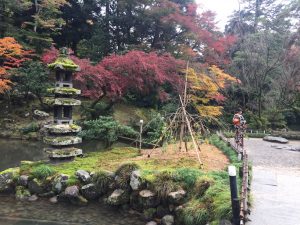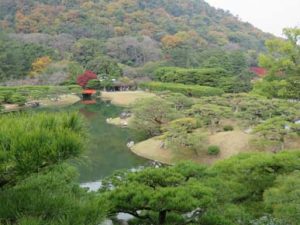Highlights
Highlights are a very personal thing as everyone has different interests. However, the ones we list below are what we have enjoyed whilst in Japan. To help you find out more about these highlights we have included the relevant page number for the 5th edition of Japan by Rail. Also see Scenic journeys, World Heritage Sites, and Hot springs (onsen).

General
- Japanese food! The best thing about eating in Japan is that you don’t need to spend a fortune to have wonderful food (see pp74-6 and see relevant town/city).
- Almost any festival, but particularly Aomori’s Nebuta (see Festivals and events), held in August. (p360)
- Rotemburo, particularly a ryokan with a rotemburo (pp85-7); see Hot springs (onsen).
- Travelling on any of the sightseeing trains (boxed text p98), but also in Gran Class on the Hayabusa shinkansen (boxed text p318).
Honshu

Tokyo
- Meiji-jingu, Tokyo’s best-known shrine, is in Harajuku (pp111-12)
- The atmosphere at Senso-ji, Asakusa (pp119-21)
- The views from Tokyo Skytree (pp122-3)
- The free view from the Metropolitan Government building, Shinjuku (pp113-14)
-
Edo-Tokyo Open-air Architectural Museum (p125); sadly Edo-Tokyo Museum(p122) is closed till 2025 for a major renovation project
- ‘Yanesen’, Nippori (pp114-15) a shitamachi (old town area of Tokyo (pp112-13)

Around Tokyo
- Kamakura (pp136-40), particularly the Daibutsu and the Enoden railway line
- Kawaguchi-ko, particularly sitting in a rotemburo and seeing the view of Mt Fuji reflected in the lake (pp140-3)
- Narita town, particularly Narita-san Shinsho-ji, but also walking down Omotesando, the main street (pp144-5)
Central Honshu

- Kanazawa, with its wonderful garden (Kenrokuen), gold-leaf museum, former geisha quarter, temple district including the so-called Ninja temple, and the former samurai district (see pp227-33)

Kenrokuen in November (© Japan by Rail) - Seeing the ‘snow monkeys’ in Jigokudani Monkey Park (pp212-14)
- Hida Folk Village (Hida no Sato), Takayama (p221)
- Shirakawa-go (pp226-7 & p233) is also a highlight but the downside of that is that during the day it is full of coach parties so we recommend spending the night there
- Climbing Fuji san (possible in summer only) (see box pp175)
- Hakone (see pp168-71) There is a lot to see in the Hakone area – not least of which is views of Mt Fuji if the weather is good. Another particular highlight is Hakone Open Air Art Museum.

One of the many sculptures and art works in Hakone Open Air Art Museum. (© Japan by Rail)
Kansai

- Kyoto, particularly the temples and gardens, but also the railway station and more recently the largest railway museum in Japan! (pp249-62)
- Arashiyama (pp263-5), near Kyoto is a great place for a change of pace and some spectacular scenery, though it is also rather touristy
- Koya-san, both staying in a temple, but also walking through Okunoin, site of the mausoleum of Kobo Daishi and also a cemetery containing graves for individuals but also company graves (pp159-61)
Western Honshu

-
Himeji Castle (p272 & pp274-5), particularly from the outside but it is essential to get a ticket to see the best views. Also recommended is Koko-en, a garden by the castle.
-
Miyajima and Itsukushima Shrine (pp309-11) The best time to come here is in the autumn for the autumn leaves, or in the spring for the cherry blossoms, but at any time it is a fascinating island. Also try to ensure you stay long enough to see the shrine at both low and high tides.
-
Korakuen(p297) is one of the three great landscape gardens in Japan and it benefits from the backdrop of Okayama Castle. The other two main gardens are Kenrokuen (p227) in Kanazawa and Kairakuen (p145) in Mito, but Ritsurin (pp478-9) in Takamatsu, Shikoku, is also highly recommended.

Tohoku
- Toshogu shrine, Nikko – even in the rain the shrine is a spectacular sight. Remember that this area is full of shrines and temples and very spread out so requires a lot of walking to see it all, but it is worth it. However, if you are tiring of temples and shrines there is also a lot more to see in Nikko (pp324-6).
- Hiraizumi, a historic temple town perhaps best known for the ‘Pure Land Garden’ at Motsu-ji (pp333-4)
- Kakunodate, a former samurai town (pp338-9)
Hokkaido
- Hakodate for its seaside as well as hilly location and its relaxed atmosphere, delicious seafood and morning market (pp388-94)
- Journey (by train of course!) from Oshamambe to Otaru and from Abashiri to Kushiro (see Scenic journeys)
- Noboribetsu-onsen (see Hot springs)
Kyushu

- Having a sand bath (see Hot springs for a photo) in naturally hot sand
- Nagasaki, a beautiful port town with a sad history but lots to see and do – as well as wonderful fresh fish to eat (see pp438-45)
- Day trip to Sakurajima (p581), a volcanic island
Shikoku

- Ritsurin-koen, a magnificent and spacious garden (pp478-9) in Takamatsu
- Dogo-onsen, Matsuyama Even though the main part of the original baths (pp492-3) here are closed for renovation until 2026, a new annexe has been constructed and includes a replica of the Yushinden, the area where any visiting Emperor can take a bath
- Day trip (or an overnight stay) to the art island, Naoshima (pp483-4)
- Awa-Odori dance festival, Tokushima held every August (see Festivals and events) (p486)
